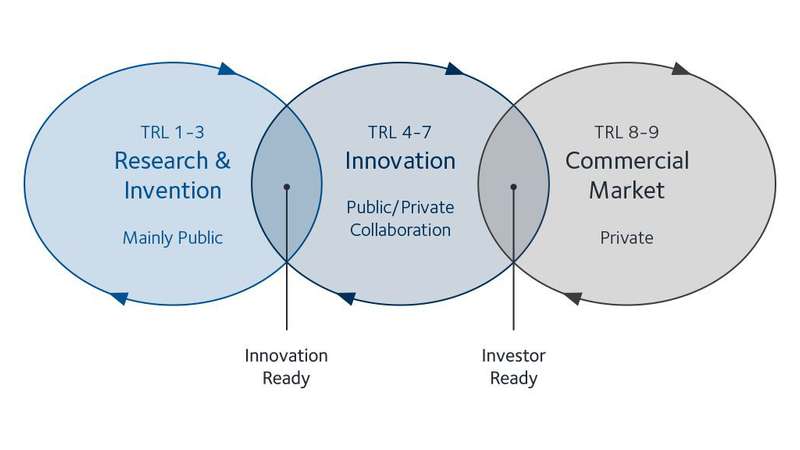The Innovation Challenge and the Valley of Death
Innovating an idea from concept to working product is rewarding but involves a long and challenging innovative process fraught with complexity.

Director of Marketing Communications

Taking an idea from basic concept to commercially available product is highly rewarding, but can be a very long, complex and difficult journey. Recognising and understanding the stages of the process, and using the right support to help you navigate through it, can mean all the difference between success and failure.
Players in today’s UK manufacturing industry face tough challenges in their quest to deliver innovative products and services that meet the needs of the technology-savvy consumer.
With consumption and demand for products and services showing no signs of slowing, UK manufacturing innovators are under constant pressure to drive the industry forward and develop technology for new and existing products. And yet it takes more than a light bulb moment to turn an ingenious idea into reality. The road from concept to market is marred with obstacles, and many businesses fail to pass beyond the development stage.
A better understanding of the innovation process is essential from the outset if the pioneers of innovation are to overcome the dangers that they are likely to face along the way, and maximise their opportunities for success.
If you are about to take an idea forward on the innovation journey, it is worth taking the time to consider the challenges that you will inevitably face along the way, as being forewarned is forearmed! CPI knows the key challenges that our partners are likely to face only too well; fortunately, we also know how best to address them. In summary, the main issues are:
- Getting into the correct mind set
- Working with the right people
- Identifying and securing the best financial resources
- Managing your cash flow
- Understanding your market place
- Seeing your idea through to prototyping
- Setting the cost and value of the products correctly
- Recognising the opportunities available
A very well publicised phenomenon in the innovation industry is known as the ‘valley of death’. This is the point of no return from which many new ideas going through the innovation process fail to progress, and even those ideas that do make it out of the valley can spend anywhere between 5 and 10 years trying to escape from it.
To understand what the valley of death is and when innovators can expect to arrive there, it’s useful to consider the concept in terms of Technology Readiness Levels (TRLs). The TRLS are the terminology used by NASA and the UK Government’s Innovate UK to demonstrate the innovation process.

The valley tends to appear at the point where a conceptual idea needs to be turned into a working prototype in order to demonstrate that it works, assess production costs, and to outline the equipment and processes needed for manufacture.
It is at this stage that organisations like CPI can support companies in assessing the potential feasibility and value of their idea and provide information and advice on the best way forward. It is equally as important to help businesses make decisions to stop some projects, as it is to focus their finances on those projects with the best chance of success.
As can be seen in CPI’s business model (outlined below), which is based on the TRL scale, our approach combines technology push with business pull to drive forward those ideas that universities and businesses are not equipped to develop themselves due to the high capital costs involved.
Investors will sometimes finance ideas to turn them into prototypes, but there is a much higher risk involved in doing this than when they can see a working prototype on which to base their decision to invest, and therefore a higher percentage of product ownership is usually demanded.
An innovating business is in a far stronger position to retain value if it has a working prototype with IP protection and production data as the product offer. An independent technology innovation centre such as CPI can help you produce this.
CPI and other industry led catapult centres offer a wealth of expertise across a wide range of technologies and services, providing world class open access facilities and equipment to demonstrate the process/product and prove it is feasible, before you invest substantial amounts of money in capital equipment and training.
This enables you to develop, prove, prototype and scale up your product, which can be demonstrated on paper, in the lab and in the plant before being manufactured at an industrial scale.

Remember – creating new ideas is invention, improving and finding new applications for existing ideas is innovation!
Step 1 – Identifying the goals or problems to be solved
The first step in the innovation process is to clarify what your business’s innovation goals are, and why you want, or need, to engage in this kind of innovation. It is important to involve a good cross section of the business in developing these goals, utilising the expertise within the organisation and even extending this to the customer and client network to get the market view.
Step 2 – Analysis
The second step consists of some real world discovery of the current situation, customers, their needs, challenges etc. It’s very easy to be subjective about an idea you have nurtured for months, so getting some objective feedback is essential. In addition to customers, it is vital to look into what the competition is doing, any trends which will impact on your business, and which innovations companies outside your industry are implementing that you can learn from. You should check inside your own company to determine what assets, resources and core competencies you have within your company that can be applied.
Step 3 – Development and design
Based on the information and thoughts gained during analysis, it is advisable to develop an ideas portfolio that includes ways you could innovate to meet these goals and problems. Once you have developed these ideas, an initial evaluation and prioritisation will lead to a portfolio of innovations you can test.
Step 4 – Conversion
Potentially the valley of death, the next requirement is to translate your ideas into practical innovation products that could be targeted towards the identified marketplace. The aim here is not to fully launch the innovative products, but to test your ideas within a limited scope to determine whether customers like the innovation, accept it and are willing to pay. This means providing prototypes complete with some basis of costing and a rudimentary process to make or design them, and this is where innovation centres like CPI are invaluable.
This is a very important step, as innovations will probably have to be modified and changed in light of customer or market feedback. Some ideas will work, others won’t; it can take some time experimenting to find the best ideas which meet the needs of a commercially viable market. Without a realistic, tangible product offer, this step is very difficult.
An additional complicating factor is the importance of protecting your intellectual property. Having the unfettered right to your own product is critical, but difficult to achieve if you rely on investors to take you from step 4 to step 5.
Step 5 – Commercialisation
The final step involves taking your tested innovations and developing them into full-scale operations. This will require access to production facilities, routes to market, logistics etc. It is here where collaborative working across the business and in industries outside the business, partnerships and sub-contracting management can play an important role.
As you successfully pass through each stage of this process, building confidence in your products and gaining a greater understanding of the technical and commercial issues you face, the risk steadily decreases. However, be mindful that the costs increase dramatically as you move from discussion through lab work to prototyping and finally to production.
The innovation journey will inevitably be influenced by the creating organisation’s culture and view on when, and with whom, to share their technology. Successful innovation requires a willingness to make use of the right kind of assistance and expertise based on a balanced assessment of risk and reward, as well as a cool headed understanding and strategy for dealing with the challenges each stage of development will present. Good luck!
Enjoyed this article? Keep reading more expert insights...
CPI ensures that great inventions gets the best opportunity to become a successfully marketed product or process. We provide industry-relevant expertise and assets, supporting proof of concept and scale up services for the development of your innovative products and processes.